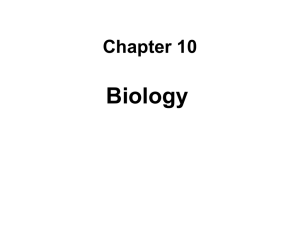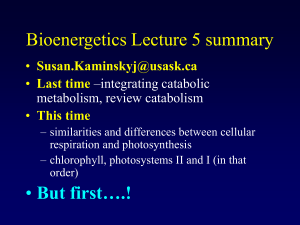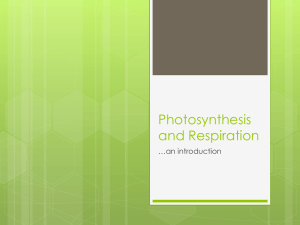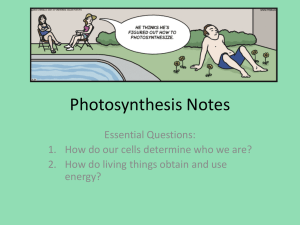Light-independent reactions
advertisement
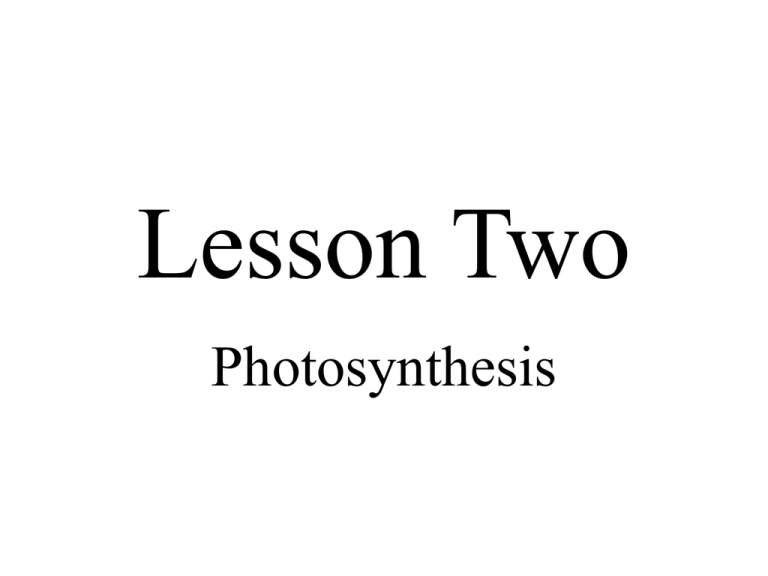
Lesson Two Photosynthesis Photosynthesis • Photosynthesis occurs only in the chlorophyllcontaining cells of green plants , algae , and certain protists and bacteria. Photosynthesis • Overall, it is a process that converts light energy into chemical energy that is stored in the form of molecular bonds. Carbon dioxide Water Glucose PHOTOSYNTHESIS Oxygen gas Photosynthesis • From the point of view of chemistry and energetics, it is the opposite of cellular respiration. Photosynthesis Potential energy of molecules • Whereas cellular respiration is highly exergonic and releases energy, reactants Amounts of energy output products Photosynthesis Potential energy of molecules • ….photosynthesis requires energy and is highly endergonic. products Amount of energy input reactants Photosynthesis • Photosynthesis starts with CO2 and H2O as raw materials and proceeds through two sets of partial reactions. In the first set, called the light-dependent reactions, water molecules are split (oxidized), O2 is released, and ATP and NADPH are formed. Photosynthesis • In the second set, called light-independent reactions, CO2 is reduced (via the addition of H atoms) to carbohydrates. These chemical events rely on the electron carrier NADPH and ATP generated by the first set of reactions. 3 CO2 1 3 P P 6 RuBP 3-PGA 6 3 ADP 3 P Lightindependent reactions 4 (CALVIN CYCLE) ATP ATP 6 ADP + P 6 NADPH 6 NADP+ 5 P 6 G3P P G3P 3 OUTPUT: 1 P G3P Glucose and other compounds Photosynthesis • Both sets of reactions take place in chloroplasts. Photosynthesis • Most of the enzymes and pigments for the light-dependent reactions are embedded in the thylakoid membrane of chloroplasts. Photosynthesis • The dark reactions take place in the stroma. stroma How Light Energy Reaches Photosynthetic Cells • The energy in light photons in the visible part of the spectrum can be captured by biological molecules to do constructive work. How Light Energy Reaches Photosynthetic Cells • The pigment chlorophyll in plant cells absorbs photons within a particular absorption spectrum – a statement of the amount of light absorbed by chlorophyll at different wavelengths. How Light Energy Reaches Photosynthetic Cells • When light is absorbed it alters the arrangement of electrons in the absorbing molecule. The added energy of the photon boosts the energy condition of the molecule from a stable state to a less-stable excited state. How Light Energy Reaches Photosynthetic Cells • During the lightdependent reactions of photosynthesis, as the absorbing molecule returns to the ground state, the “excess” excitation energy is transmitted to other molecules and stored as chemical energy. How Light Energy Reaches Photosynthetic Cells • All photosynthetic organisms contain various classes of chlorophylls and one or more carotenoid (accessory) pigments that also contribute to photosynthesis. How Light Energy Reaches Photosynthetic Cells • Groups of pigment molecules called antenna complexes are present on thylakoids. How Light Energy Reaches Photosynthetic Cells • Light striking any one of the pigment molecules is funneled to a special chlorophyll a molecule, termed a reaction-center chlorophyll, which directly participates in photosynthesis. How Light Energy Reaches Photosynthetic Cells • Most photosynthetic organisms possess two types of reaction-center chlorophylls, P680 and P700, each associated with an electron acceptor molecule and an electron donor. These aggregations are known respectively as photosystem I (P700) and photosystem II (P680). How Light Energy Reaches Photosynthetic Cells The Light-Dependent Reaction: Converting Solar Energy into Chemical-Bond Energy The Light-Dependent Reaction • The photosystems of the light-dependent reactions are responsible for the packaging of light energy in the chemical compounds ATP and NADPH. The packaging takes place through a series of oxidationreduction reactions set in motion when light strikes the P680 reaction center in photosystem II. The Light-Dependent Reaction • In this initial event water molecules are cleaved, oxygen is released, and electrons are donated. These electrons are accepted first by plastoquinone and then by a series of carriers as they descend an electron transport chain. The Light-Dependent Reaction • For each four electrons that pass down the chain, two ATPs are formed. The last acceptor in the chain is the P700 reaction center of photosystem I. The Light-Dependent Reaction • At this point incoming photons boost the energy of the electrons, and they are accepted by ferredoxin. The Light-Dependent Reaction • Ferredoxin is then reoxidized, and the coenzyme NADP+ is reduced to the NADPH. The ATP generated previously and the NADPH then take part in the lightindependent reactions. The Light –Dependent Reaction • The production of ATP from the transport of electrons excited by light energy down an electron transport chain is termed photophosphorylation. The one-way flow of electrons through photosystems II and I is called noncyclic photophosphorylation; The Light-Dependent Reaction • …plants also derive additional ATP through cyclic photophosphorylation, in which some electrons are shunted back through the electron transport chain between photosystems II and I. The Light-Independent Reactions: Building Carbohydrates • In the light-independent reactions of photosynthesis, which are driven by ATP and NADPH, CO2 is converted to carbohydrate. The reactions are also known as the Calvin-Benson cycle. The Light-Independent Reactions • Atmospheric CO2 is fixed as it reacts with ribulose 1,5bisphosphate (RuBP), a reaction that is catalyzed by the enzyme ribulose 1,5bisphosphate carboxylase (rubisco). The Light-Independent Reactions • The reduction of CO2 to carbohydrate (fructose 1,6bisphosphate) is completed via several more steps of the cycle. Glyceraldehyde 3-phosphate The Light-Independent Reactions • Finally, RuBP is regenerated so that the cycle may continue. Oxygen: An Inhibitor of Photosynthesis • High levels of oxygen in plant cells can disrupt photosynthesis and can also cause photorespiration – an inefficient form of the dark reactions in which O2 is fixed rather than CO2 and no carbohydrate is produced. rubisco Reprieve from Photorespiration: The C4 pathway • Most plants are C3 plants; they experience decreased carbohydrate production under hot, dry conditions as a result of the effects of photorespiration. The C4 pathway • Among C4 plants, however, special leaf anatomy and a unique biochemical pathway enable the plant to thrive in arid conditions. The C4 pathway • Thus C4 plants lessen photorespiration by carrying out photosynthesis only in cells that are insulated from high levels of CO2. They also possess a novel mechanism for carbon fixation. Glossary • • • • • • Absorption spectrum Calvin-Benson cycle Carotenoid Chlorophyll Chloroplast Cyclic photophosphorylation • C3 plant • C4 plant • Light-dependent reactions • Light-independent reactions • Noncyclic photophosphorylation • Photon • Photophosphorylation • Photosynthesis • Photosystem • Ribulose 1,5-bisphosphate • thylakoid Absorption spectrum • A graphic representation of the amount of light energy absorbed by a substance plotted against the wavelength of the light (From Taiz and Zeiger, Plant Physiology, 3e). Calvin-Benson Cycle (Calvin Cycle) • The biochemical pathway for the reduction of CO2 to carbohydrate. The cycle involves three phases. Carotenoid • Linear polyenes arranged as a planar zigzag chain, with the repeating conjugated double-bond system –CH=CHCCH3=CH-. These orange pigments serve both as antenna pigments and photoprotective agents. Chlorophyll • A group of light absorbing green pigments active in photosynthesis. Chloroplast • The organelle that is the site of photosynthesis in eukaryotic photosynthetic organisms. Cyclic photophosphorylation (cyclic electron flow) • In photosystem I, flow of electrons from the electron acceptors through the cytochrome b6f complex and back to P700, coupled to proton pumping into the lumen. This electron flow energizes ATP synthesis but does not oxidize water or reduce NADP+. C3 plant • Plants in which the first stable product of photosynthetic CO2 fixation is a threecarbon compound (i.e. 3-phosphoglycerate). C4 plant • Plants in which the first stable product of CO2 assimilation in mesophyll cells is a four-carbon compound that is immediately transported to bundle sheath cells and decarboxylated. The CO2 released enters the Calvin cycle. Light-dependent reactions • photosynthetic electron transport • Electrons flow from light-excited chlorophyll and the oxidation of water, through PSII and PSI, to the final electron acceptor NADP+. Light-independent reactions • Dark reactions • Calvin-Benson cycle • Calvin cycle Noncyclic photophosphorylation • Noncyclic electron flow • Electrons flow from light-excited chlorophyll and the oxidation of water, through PSII and PSI, to the final electron acceptor NADP+. Photon • A discrete physical unit of radiant energy. • A particle that has zero mass or charge and unit spin, the quantum of the electromagnetic field and carrier of the electromagnetic force Photophosphorylation • The formation of ATP from ADP and inorganic phosphate (Pi) using light energy stored in the proton gradient across the thylakoid membrane. Photorespiration • Uptake of atmospheric O2 with a concomitant release of CO2 by illuminated leaves. Molecular oxygen serves as substrate for rubisco and the formed 2-phosphoglycolate enters the photorespiratory carbon oxidation cycle. The activity of the cycle recovers some of the carbon found in 2phosphoglycolate, but some is lost to the atmosphere. Photosynthesis • The conversion of light energy to chemical energy by photosynthetic pigments using water and CO2, and producing carbohydrates. Photosystem • A functional unit in the chloroplast that harvests light energy to power electron transfer and to generate a proton motive force used to synthesize ATP. Ribulose 1,5-bisphosphate (RuBP) • A compound with a backbone of five carbon atoms that is required for carbon fixation in the CalvinBenson cycle of photosysthesis. Thylakoid • The specialized, internal, chlorophyll containing membranes of the chloroplast where light absorption and the chemical reactions of photosynthesis take place.


